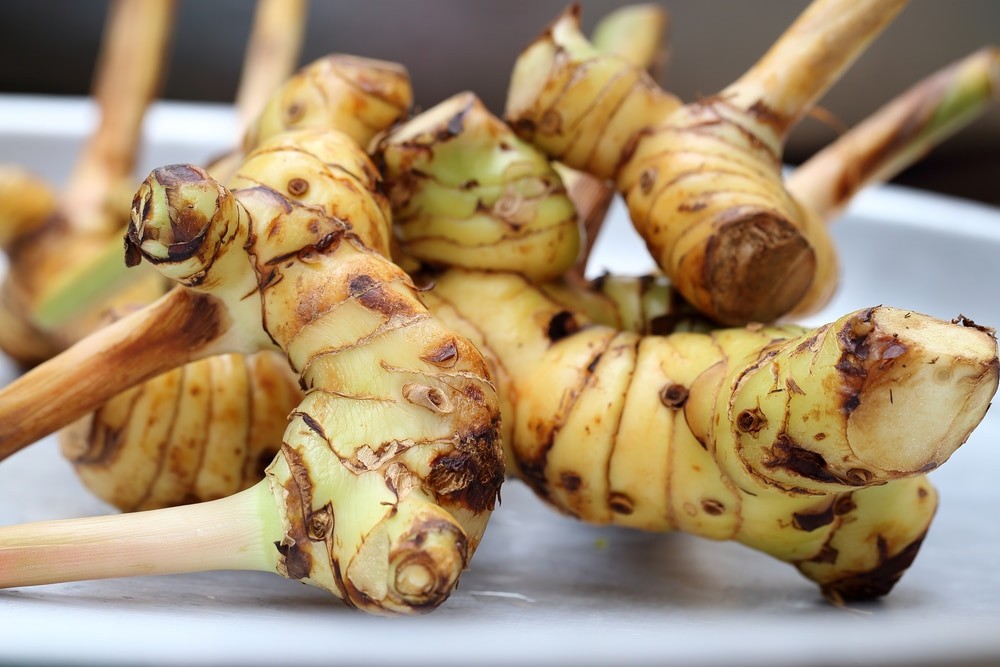
Contents
- 1 Galangal and Ginger Root: What Are the Differences and Health Benefits?
- 1.0.1 What is ginger?
- 1.0.2 What are the differences and similarities between galangal and ginger?
- 1.0.3 What are the health benefits of galangal root?
- 1.0.4 What are the health benefits of ginger root?
- 1.0.5 What are possible uses for both?
- 1.0.6 How much of each should you take?
- 1.0.7 When should you talk to your doctor?
Galangal and Ginger Root: What Are the Differences and Health Benefits?
Galangal and ginger are plants from the Zingiberaceae family. Galangal is good for stomachache, colds, and swelling, while ginger is good for arthritis, colds, headaches, and stomachaches.
These plants grow in similar parts of the world and have both been used in traditional medicine for thousands of years.
Scientists have studied ginger more than galangal, but research into both plants is ongoing.
The scientific name for galangal is Alpinia officinarum. It naturally grows in parts of the world near:
Galangal plants have thick rhizomes, which are the underground stems of plants that store starches and produce root systems.
Galangal plants also have ornamental leaves and large, white flowers.
These plants arrived in Europe during the Middle Ages.
What is ginger?
The official name for the ginger plant is Zingiber officinale. It mostly grows in Asia.
Like galangal, the most familiar part of ginger is the rhizome, which is thick, full of knots, and beige in color.
Above ground, the plant has thin, heavily-ribbed leaves and moderately sized flowers that are usually white or yellowish-green.
Ginger has been used in cooking for over 4,000 years and in medicine for at least 2,000 years.
What are the differences and similarities between galangal and ginger?
Since galangal and ginger come from the same plant family, they have many properties in common. Both have been used in Ayurvedic medicine and traditional Chinese medicine for thousands of years. Ayurvedic medicine is traditional Indian medicine.
Both plants mostly use the rhizomes for medicinal purposes, and root extracts are sometimes used as well.
Both plants contain a large number of biologically active compounds that impact overall health.
However, there are bioactive molecules found in one plant but not the other. For example, ginger contains gingerols, which have not been reported in galangal extracts.
Extracts from both plants are sometimes used in combination in clinical trials.
What are the health benefits of galangal root?
Galangal root has many uses in traditional medicine, including treating stomachaches, common cold symptoms, and swelling. It is also thought to have anti-inflammatory, antioxidant, antiulcer, antidiarrhea, anticoagulant, antidiabetic properties, and has been used to treat hemorrhoids.
More research is needed to verify these health claims, but there is some evidence that galangal can assist with chemotherapy, work as an antibacterial agent, and provide pain relief through its anti-inflammatory properties.
Recent studies have confirmed that some compounds found in galangal display antioxidant and antibacterial properties in test tubes.
What are the health benefits of ginger root?
Ginger root has been used to treat a wide range of health conditions, including arthritis, nausea, motion-sickness, and pregnancy-related stomach problems.
Ginger has shown positive effects on stomach problems caused by pregnancy, chemotherapy, and motion-sickness.
Research is still ongoing to explore other potential uses for ginger.
QUESTION
What are possible uses for both?
Studies have found that a combination of galangal and ginger can help reduce knee pain and potentially supplement chemotherapy. Galangal has also shown stronger antimicrobial effects than ginger.
How much of each should you take?
The amount of galangal needed for positive health effects is unclear, but for ginger, adults should not ingest more than four grams a day from any source. Typical studies use one gram of ginger a day or less.
Children under two years old should not consume these plants or their extracts.
When should you talk to your doctor?
Always talk to your doctor before introducing galangal or ginger extracts to your diet. Ginger may interfere with certain medications, like blood thinners.
Your doctor can recommend the best dosage and provide pure extracts. They can also monitor your health to ensure there are no negative side effects.
Sources:
Asian Pacific Journal of Cancer Prevention: "Revealing the Reversal Effect of Galangal (Alpinia galanga L.) Extract Against Oxidative Stress in Metastatic Breast Cancer Cells and Normal Fibroblast Cells Intended as a Co- Chemotherapeutic and Anti-Ageing Agent."
Herbal Gram: "Are Ginger and Willow Bark Extracts Viable Alternatives to Treat Osteoarthritis?"
Johns Hopkins Medicine: "Ginger Benefits."
LWT – Food Science and Technology: "Antimicrobial properties and action of galangal (Alpinia galanga Linn.) on Staphylococcus aureus."
Mount Sinai: "Ginger."
Pharmacognosy Review: "A Review on the Pharmacological Activities and Phytochemicals of Alpinia officinarum (Galangal) Extracts Derived from Bioassay-Guided Fractionation and Isolation."
Trends in Food Science and Technology: "Galangal, the multipotent super spices: A comprehensive review."
University of Rochester Medical Center: "Ginger."
University of Rochester Medical Center: "Ginger."


